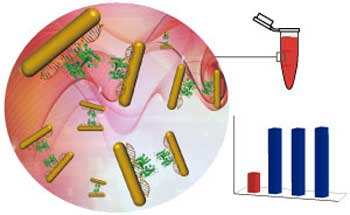| Posted: Jul 12, 2017 |
Biocomputing - DNA and gold nanorods give a logical solution
(Nanowerk News) By adding strands of DNA to a solution containing gold nanorods, A*STAR researchers have created a remarkably simple system that can ‘compute’ basic logic operations like OR and NOT in response to specific molecular inputs (Nanoscale, "A plasmonic multi-logic gate platform based on sequence-specific binding of estrogen receptors and gold nanorods"). This has potential applications in rapid and complex diagnostic systems.
|
 |
| Gold nanorods coated with dsDNA act like an OR logic gate in the presence of estrogen receptor proteins ERα and ERβ. (Image: A*STAR Institute of Materials Research and Engineering)
|
|
Clinical diagnostics often rely on the detection of pathogens and disease biomarkers from samples of blood or other biological fluids from patients. Most such tests produce a simple ‘true’ or ‘false’ result for the presence of a single biomarker. The ability to perform logic operations such as AND and OR for two or more biomarkers could greatly increase the diagnostic power of such tests. Progress in building biomolecular logic gates is hampered by the complex and chemically demanding modifications required to produce practical logic systems.
|
|
Xiao Di Su and colleagues from the A*STAR Institute of Materials Research and Engineering and University College London have devised a highly versatile and reliable diagnostic system using gold nanorods, DNA and proteins, that is both easy to create and offers the potential for sophisticated logic-based computing operations.
|
|
“We have taken human gene regulation, one of the most precise mechanisms in nature, and applied it to develop the basis of a new technology in the field of biocomputing,” says Su.
|
|
Gold nanorods absorb light at specific wavelengths determined by the rods’ dimensions, but the degree of absorption is controlled by the aggregation of the nanorods in solution. Su and her colleagues found that when double-stranded DNA (dsDNA) was added to the nanorod solution, the aggregation of the nanorods could be reliably controlled by the dsDNA concentration.
|
|
To demonstrate the system, the researchers created the solution using DNA segments containing the DNA sequence for estrogen receptor (ER) elements, which would allow the system to respond to the addition of ER proteins. They found that the system could be configured to give an OR result – a change from a ‘low’ to ‘high’ absorbance level when one or both of the two different ER variants (ERα and ERβ) were added to the solution – as well as a NOT result in response to dsDNA addition. The team then demonstrated other logic functions (IMPLY, FALSE, TRUE and BUFFER), which when arranged in series formed the basis for more complex logic operations.
|
|
“This is a simple, yet highly versatile platform that does not rely on nanomaterial functionalization or other complicated fabrication methods, and demonstrates the huge potential of nature-inspired applications using biological binding events to manipulate the optical properties of nanomaterials,” says Su.
|

